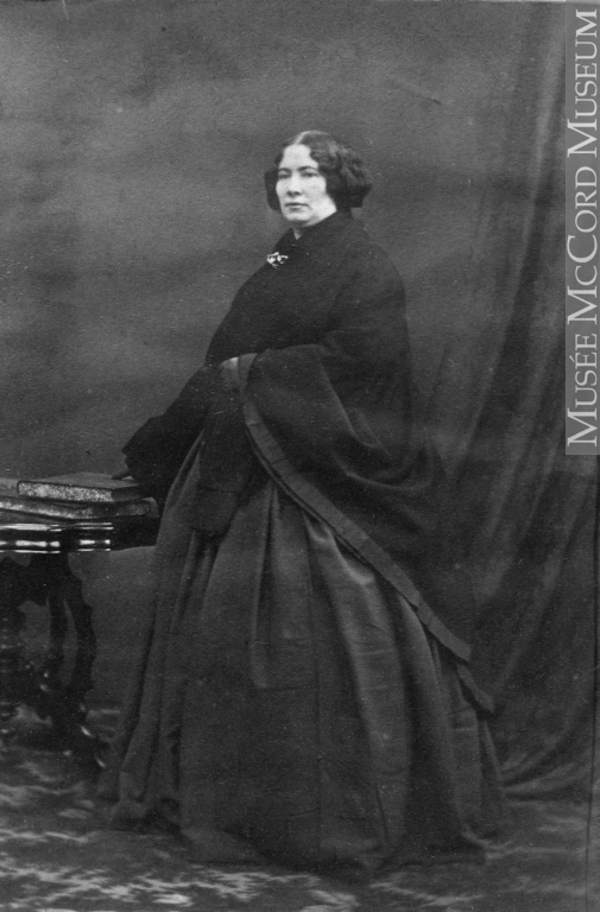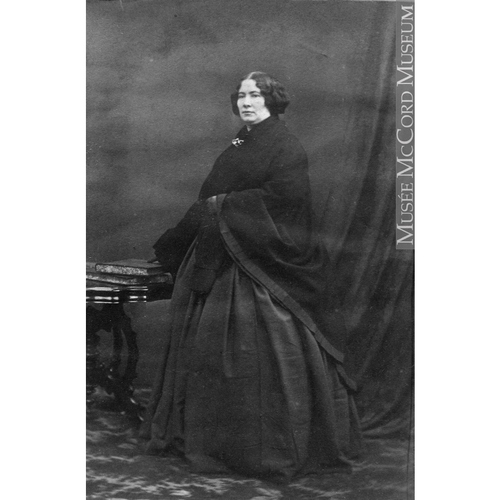
Source: Link
HORN, KATE M. (Buckland), actress and theatre director; b. c. 1826 in Ireland; m. 1852 in New York State John Wellington Buckland, a financier and theatre manager; they had no children; d. 10 Sept. 1896 in Montreal.
Orphaned before the age of 16, Kate Horn made her stage debut in Charleston, S.C., under the patronage of actress Sarah H. Timm, and she accompanied her to New York in 1841. However, her first important regular engagement began on 24 March 1845, in the celebrated Park Theatre in that city, when she played Seraphina in Fashion. She was thought to be “one of the most beautiful women on the stage,” and soon became a favourite of the American public. Her partners were among the most renowned actors of the time: George Clifford Jordan and his wife Annie Walters, Charlotte Saunders Cushman, Edward Loomis Davenport, and William Pleater Davidge.
In 1852 Kate’s husband and his partner W. Corbyn, who together managed the Lyceum Theatre in New York, accepted an offer to direct the new Theatre Royal on Rue Côté in Montreal, the fourth theatre to bear that name. Their main task was to hire a resident troupe for a season of English-language drama in Montreal. The first performance of the company, which included Kate, was scheduled for 15 July 1852. The evening before the official opening, however, the actors gave a benefit performance to aid victims of the great fire of 8 July. In one of the plays on the bill, The serious family, Kate, acting under her married name, played the role of the widow Delmaine. Both audience and critics, especially the Montreal Gazette, gave her an enthusiastic reception: “In the first place, Mrs Buckland has almost walked into our ‘heart of hearts.’ If we were going to marry a widow, we do think it would be Widow Delmaine.” The following day she played Lydia Languish in Sheridan’s The rivals.
As the Montreal season lasted only a few weeks, Kate divided her time between Montreal and New York, where she was a member of several companies, including Lester Wallack’s. In 1864 the Bucklands settled permanently in Montreal. At the Theatre Royal, Kate built up a varied repertoire which included Shakespeare and Sheridan as well as such now forgotten dramatists as Edward Bulwer-Lytton, Tom Taylor, and James Robinson Planché. From 1863 to 1866 she was involved in at least 26 amateur theatrical evenings organized by officers of the Montreal garrison at the theatre, taking part in the production of Dolorsolatio, a Canadian “extravaganza” by Sam Scribble. In this long allegory, which has characters named after the main cities of Canada, Kate played the role of Montreal, “an elegant young lady.” In 1864–65 she befriended an American actor who joined the resident troupe for a short engagement, John Wilkes Booth, the future assassin of Abraham Lincoln.
The Bucklands were soon very much a part of fashionable society in Montreal and Lower Canada. They were frequent guests at receptions given by officers of the garrison and by the colonial government. Except for a brief period in 1868 and 1869, John continued to manage the Royal until he fell ill with the disease that led to his death on 20 Nov. 1872. In the middle of the 1873–74 season Kate assumed control of the theatre, but shortly thereafter she turned over its artistic direction to a succession of impresarios, keeping in her own hands only the overall management. In 1879–80 she was replaced by John B. Sparrow*.
Even in retirement, Kate continued to take an interest in Montreal’s theatrical life and to give encouragement and advice to amateur groups in the city. She died in 1896 after a four-month illness. Her funeral, held on 12 September in St Patrick’s, a Catholic church, was attended by nephews from the United States, politicians, and members of the theatrical community. In her will she left bequests totalling $20,000, with $5,000 going to charity and the remainder to her three surviving relatives. The rest of her fortune consisted largely of shares in banking-houses and companies, as well as bonds and mortgages.
Kate Horn Buckland was remembered by her contemporaries not only as a vivacious and generous woman but also as an accomplished actress. In July 1852 the Montreal Gazette, in one of the first reviews written about her in the Canadian press, succinctly observed: “One can see with half an eye that she has been educated in a good school, and is not to be spoilt even by transatlantic usages.”
ANQ-M, CE1–63, 23 nov. 1872; CM1, 2/14, 22 sept. 1896. McGill Univ. Libraries, Dept. of Rare Books and Special Coll.,
Cite This Article
Mireille Barrière, “HORN, KATE M. (Buckland),” in Dictionary of Canadian Biography, vol. 12, University of Toronto/Université Laval, 2003–, accessed January 18, 2026, https://www.biographi.ca/en/bio/horn_kate_m_12E.html.
The citation above shows the format for footnotes and endnotes according to the Chicago manual of style (16th edition). Information to be used in other citation formats:
| Permalink: | https://www.biographi.ca/en/bio/horn_kate_m_12E.html |
| Author of Article: | Mireille Barrière |
| Title of Article: | HORN, KATE M. (Buckland) |
| Publication Name: | Dictionary of Canadian Biography, vol. 12 |
| Publisher: | University of Toronto/Université Laval |
| Year of publication: | 1990 |
| Year of revision: | 1990 |
| Access Date: | January 18, 2026 |



